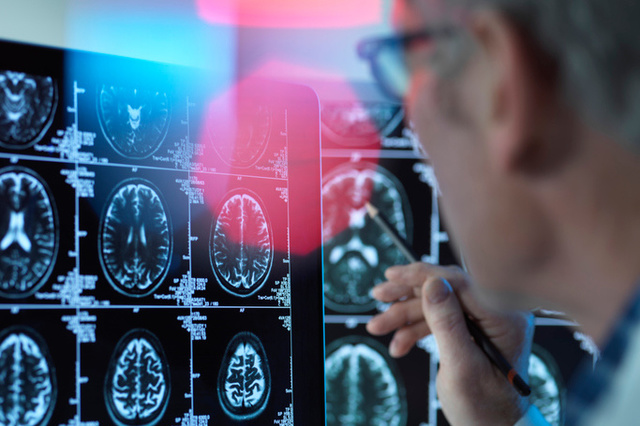Clusters of toxic proteins, thought to be responsible for the cognitive decline in Alzheimer’s disease, reach different parts of the brain and accumulate there for decades. That’s according to a new study published Friday.
The article, published in Science Advances, is the first to use human data to quantify the rate of molecular processes leading to the neurodegenerative disease. It could affect the way treatments are developed.
It disproves the theory that clusters form in one place and set off a chain reaction in other areas, a pattern seen in mice. Such spread may occur, but is not the primary factor, the researchers say.
“Two things made this possible,” said Georg Meisl, a chemist at the University of Cambridge and one of the lead authors of the paper. ‘First, the study of very detailed data from PET scans and various data sets collected, and the mathematical models that have been developed over the last ten years.’
The researchers used 400 brain samples taken after the death of people with Alzheimer’s disease and 100 PET scans of people living with the disease to track the clumping of tau protein. Tau and another protein, beta-amyloid, build up, causing brain cells to die and the brain to shrink. That causes memory loss and an inability to perform everyday tasks.
The disease is a major public health problem, affecting more than 40 million people worldwide.
The researchers also found that it takes five years for the aggregates (clumped proteins) to double in number. That’s an “encouraging” figure, Meisl says, because it shows that neurons (or nerve cells) are already capable of fighting aggregates. “Maybe if we can improve them a little bit, we can significantly delay the onset of the serious disease.”
Alzheimer’s disease is classified according to the ‘stages of Braak’. The scientists found that it takes about 35 years to progress from stage 3, which involves mild symptoms, to stage 6, the most advanced stage. The aggregates grow exponentially, which explains “why it takes so long for the disease to develop, and why people tend to get worse quickly,” Meisl said.
The research team wants to apply the same methods to study traumatic brain injury and frontotemporal dementia, in which tau protein also plays a role.
The paper, published in Science Advances, is the first to use human data to quantify the speed of molecular processes leading to the neurodegenerative disease. It could affect the way treatments are developed. It disproves the theory that clusters form in one place and set off a chain reaction in other areas, a pattern seen in mice. Such spread may occur, but is not the primary factor, the researchers say. “Two things made this possible,” said Georg Meisl, a chemist at the University of Cambridge and one of the lead authors of the paper. ‘First, the study of very detailed data from PET scans and various data sets collected, and the mathematical models that have been developed over the last ten years.’ The researchers used 400 brain samples taken after the death of people with Alzheimer’s disease and 100 PET scans of people living with the disease to track the clumping of tau protein. Tau and another protein, beta-amyloid, build up, causing brain cells to die and the brain to shrink. That causes memory loss and an inability to perform everyday tasks. The disease is a major public health problem, affecting more than 40 million people worldwide. The researchers also found that it takes five years for the aggregates (clumped proteins) to double in number. That’s an “encouraging” figure, Meisl says, because it shows that neurons (or nerve cells) are already capable of fighting aggregates. “Maybe if we can improve them a little bit, we can significantly delay the onset of the serious disease.” Alzheimer’s disease is classified according to the ‘stages of Braak’. The scientists found that it takes about 35 years to progress from stage 3, which involves mild symptoms, to stage 6, the most advanced stage. The aggregates grow exponentially, which explains “why it takes so long for the disease to develop, and why people tend to get worse quickly,” Meisl said. The research team wants to apply the same methods to study traumatic brain injury and frontotemporal dementia, in which tau protein also plays a role.
– .


